摘 要: 文章探讨了网纹纹藤壶(Amphibalanus reticulatus)幼虫处于12°C、18°C、24°C、30°C和36°C环境中的发育和附着状况。结果表明,网纹纹藤壶无节幼虫经历96h的发育后,幼虫的存活率分别为99.0%±1.2%(12°C)、95.0%±4.8%(18°C)、92.0%±2.8%(24°C)、80.0%±10.6%(30°C)和0 (36°C);在12~30°C的范围内,温度升高能显着促进幼虫的发育。网纹纹藤壶金星幼虫在96h的培养过程中,其存活率在所有温度条件下始终维持在100%;在18°C至36°C的温度范围内金星幼虫均可附着,其中30°C条件下附着率最高,可达84.5%±12.1%,而在12°C则始终无金星幼虫附着。综合幼虫的存活率、发育进程和附着状况来看,网纹纹藤壶幼虫发育及附着的适宜温度为18~30°C。
关键词: 网纹纹藤壶; 温度; 幼虫; 发育; 附着;
Abstract: Temperature is one of the most important environmental factors affecting marine life.It is of great significance for academic and industrial communities to understand its influence on the larval development and settlement of the acorn barnacle Amphibalanus reticulatus.In the present study,two experiments were carried out,one for the effect of temperature on the development of nauplii and the other for the settlement of cyprids.In ExperimentⅠ,newly-hatched nauplii were reared at12°C,18°C,24°C,30°C,and 36°C,respectively,fed by the alga Platymonas subcordiformis with initial concentration around 8.0×104 cells·mL–1.After 96 hours,the surviving individuals were counted and their developmental stages analysed.In ExperimentⅡ,cyprids were maintained in the same temperature regimes as ExperimentⅠfor 96 hours,but without providing algal food.The numbers of surviving individuals were recorded regularly as those that had settled.In ExperimentⅠ,the larval survival rates were 99.0%±1.2%(12°C),95.0%±4.8%(18°C),92.0%±2.8%(24°C),80.0%±10.6%(30°C),and 0 (36°C),with the larvae developing fastest at 30°C,followed by 24°C,18°C and 12°C,based on the larval proportions at various stages.In ExperimentⅡ,the cypris survival rate was 100%at all designated temperatures;and although settlement occurred over a wide range of temperature (18~36°C),it was the highest at 30°C reaching 84.5%±12.1%.The statistical analysis indicated that there were significant differences in larval development and settlement between the group at 30°C and those at 12°C,18°C and 24°C.In general,it can be concluded that from 12°C to 30°C,the larval development and settlement were promoted by increasing temperature.Cyprids presented a better tolerance to high temperatures than nauplii.No nauplii survived at 36°C and no cyprids settled at 12°C.In considering the survival rate,development status and settlement percentage of the larvae,18~30°C should be the appropriate temperatures for larval development and settlement of the acorn barnacle A.reticulatus.
Keyword: Amphibalanus reticulatus; temperature; larvae; development; settlement;
在自然环境中,无脊椎动物不仅是海洋生物群落的重要组成部分,也是生态系统中物质循环和能量流动的必要环节,同时在人们的日常生活中也占据着极为重要的地位(张士璀等,2017)。温度、盐度、光照、饵料和海流等环境要素直接影响无脊椎动物的生长发育、繁殖扩散及其分布状况(Anil et al,1995;Tan et al,1996;Cosson-Sarradin et al,1998;Pechenik et al,2000;Zhang et al,2015;Khalaman et al,2016)。
无柄蔓足类为营固着生活且拥有浮游生活阶段幼体的海洋甲壳动物,是典型的底栖生物类群,在各类沿海生境中几乎无处不在(刘瑞玉等,2007),常常成为人工设施上污损生物群落的主要成员(饶小珍等,2013;Cao et al,2013),而且浮游幼体的大量出现还可能会对特定海域的浮游生物群落产生显着影响(Muxagata et al,2004;Ziadi et al,2015)。鉴于该类生物的特殊性和重要性,目前已在其生长发育、繁殖、附着、分类鉴定、生态特点及培养技术等方面开展了大量研究(Anderson,1994;刘瑞玉等,2007;薛俊增等,2009;严涛等,2012;Jones,2012;Sukparangsi et al,2019)。
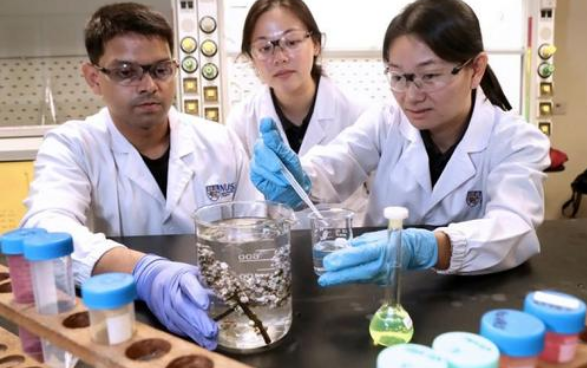
网纹纹藤壶(Amphibalanus reticulatus)为热带亚热带暖水种,是污损生物群落中的重要组成(Thiyagarajan et al,1996;Cao et al,2013),其营浮游生活的幼体由无节幼虫和金星幼虫两个阶段构成。目前,人们已探讨了盐度(Thiyagarajan et al,2002;曹文浩等,2018)、饵料(Thiyagarajan et al,1996;曹文浩等,2014)和金属离子(梁志等,1983;胡煜峰等,2014)等因素对其幼虫的影响,但温度这一关键因子的生物效应尚未见系统研究。本文研究了网纹纹藤壶幼虫在不同温度环境中的发育和附着状况,以期积累基础数据,为海洋生态研究和污损生物防除提供参考。
1 、材料与方法
1.1、 藤壶采集与幼虫孵化
网纹纹藤壶采集于深圳大亚湾海域的贝类养殖浮筏。采集时选择外壳完好、表面洁净且较大的成熟个体带回实验室。将采集到的藤壶样品解剖,摘取褐色的成熟受精卵块,放入盛有300m L过滤消毒海水的500m L烧杯中,数分钟后即可孵化出网纹纹藤壶的Ⅰ期无节幼虫。借助幼虫的趋光习性收集活泼健壮的Ⅰ期无节幼虫,部分用于海水温度对幼虫发育影响的实验,另一部分用于培养藤壶金星幼虫。
1.2、 温度对幼虫发育影响
实验容器采用100m L烧杯。每个烧杯中加入过滤消毒海水并投放亚心形扁藻(Platymonas subcordiformis)作为饵料,投放量约为8.0×104个·m L–1,使烧杯内的培养液总量为50m L,然后各放入50只刚孵化的网纹纹藤壶Ⅰ期无节幼虫。实验设置12°C、18°C、24°C、30°C和36°C 5个温度梯度,每个温度各设4个平行样,置于恒温培养箱内于黑暗环境中培养,期间每天8:00和17:00前后将烧杯取出,自然光照10min。培养96h后,记录存活的幼虫数目,并将其移至小试管中,滴加体积分数5%的福尔马林溶液杀死幼虫,于显微镜下观察幼虫的背甲、尾突、腹突、附肢等形态特征,确定其所处的发育阶段(严文侠等,1980),分析其发育状况,统计各期幼虫的百分率。
1.3 、温度对幼虫附着影响
1.3.1 、金星幼虫培养
在1L烧杯中加入适量海水,以亚心形扁藻作为饵料,投放量约为2.5×105~3.0×105个·m L–1,将活泼健壮的Ⅰ期无节幼虫转移到其中,培养密度为1~2只·m L–1,置于恒温培养箱,30°C左右黑暗环境中培养,每天早晨和傍晚取出光照各30min。待金星幼虫大量出现后,采集发育良好、健康活泼的个体置于盛有少量消毒海水的50m L烧杯内,放入4°C冰箱内储存备用。
1.3.2、 幼虫附着实验
选用直径为6cm的培养皿进行金星幼虫附着实验,实验设置12°C、18°C、24°C、30°C和36°C 5个温度梯度,每个温度各设4个平行样。各培养皿分别加入13m L过滤消毒海水,放入约30只金星幼虫,放置于相应温度的培养箱内黑暗环境中培养,每24h观察一次,记录幼虫的生存与附着状况,连续观察96h。
1.4 、统计分析
网纹纹藤壶的幼虫存活率、各期幼虫百分率、金星幼虫存活率和附着率等数据均以平均值±标准差表示,经最小显着差数法检验各温度组数据之间的差异显着性。p>0.05为无显着性差异,p<0.05为差异显着,而p<0.01则表示差异极显着。以上所有数据的处理均通过SPSS Statistics 17.0软件完成。
2 、结果
2.1、 温度对幼虫发育影响
图1显示了不同温度培养条件下网纹纹藤壶幼虫的存活状况。可见,12°C、18°C和24°C 3个温度组的幼虫平均存活率分别为99.0%±1.2%、95.0%±4.8%和92.0%±2.8%,它们之间无显着差异(p>0.05);30°C温度组幼虫存活率为80.0%±10.6%,显着低于12°C、18°C和24°C 3个温度组(p<0.01);而36°C温度组的幼虫存活率为0,与其他组之间的差异极其显着(p<0.01)。
图1 不同温度条件下网纹纹藤壶幼虫的存活率
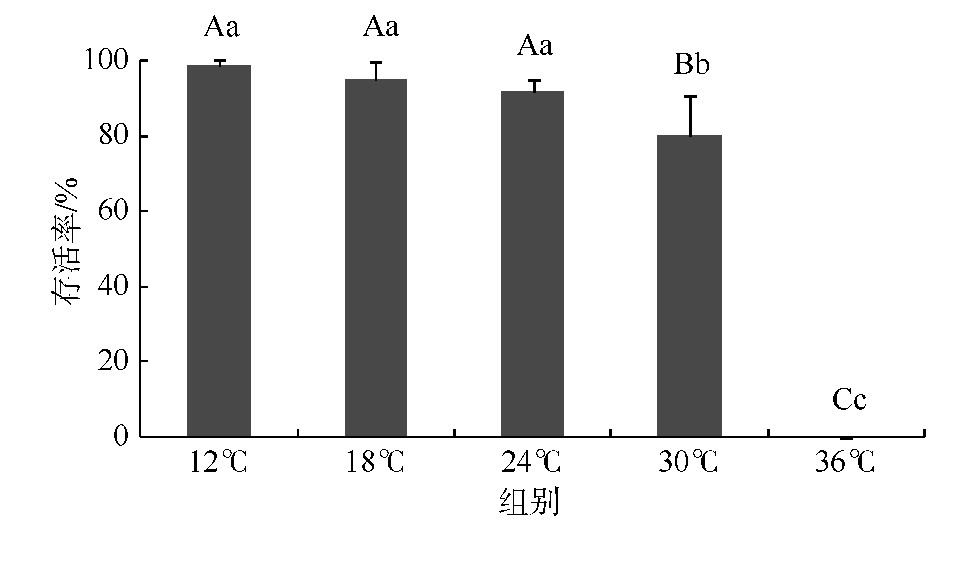
Fig.1 The larval survival rates of Amphibalanus reticulatus under different temperatures
图中标注的不同大写字母表示相关组间差异极显着(p<0.01);不同小写字母表示组间差异显着(p<0.05);相同小写字母则表示组间差异不显着(p>0.05);样品重复数n=4
图2显示了不同温度培养环境中各期幼虫所占的百分率。30°C组的幼虫发育状况最好,分别处在无节幼虫的Ⅳ期(10.0%±1.6%)、Ⅴ期(60.5%±6.6%)和Ⅵ期(9.5%±4.4%),未见Ⅱ期和Ⅲ期无节幼虫。在12°C组中,仅出现Ⅱ期和Ⅲ期无节幼虫,其中Ⅱ期占5.5%±4.4%,Ⅲ期占93.5%±4.7%,均与其他温度组差异极显着(p<0.01)。18°C组,其幼虫则处于Ⅲ期(45.5%±7.2%)、Ⅳ期(43.0%±5.0%)和Ⅴ期(6.5%±3.0%),其中Ⅲ期和Ⅳ期的百分率均高于30°C温度组(p<0.01),Ⅴ期则明显低于30°C组(p<0.01)。在24°C组中,Ⅲ期无节幼虫占8.0%±5.9%,Ⅳ期为36.2%±2.5%,均高于30°C组(p<0.05),而Ⅴ期和Ⅵ期无节幼虫则分别占47.0%±3.5%和0.5%±1.0%,明显低于30°C温度组(p<0.01)。
图2 不同温度条件下网纹纹藤壶各期幼虫百分率
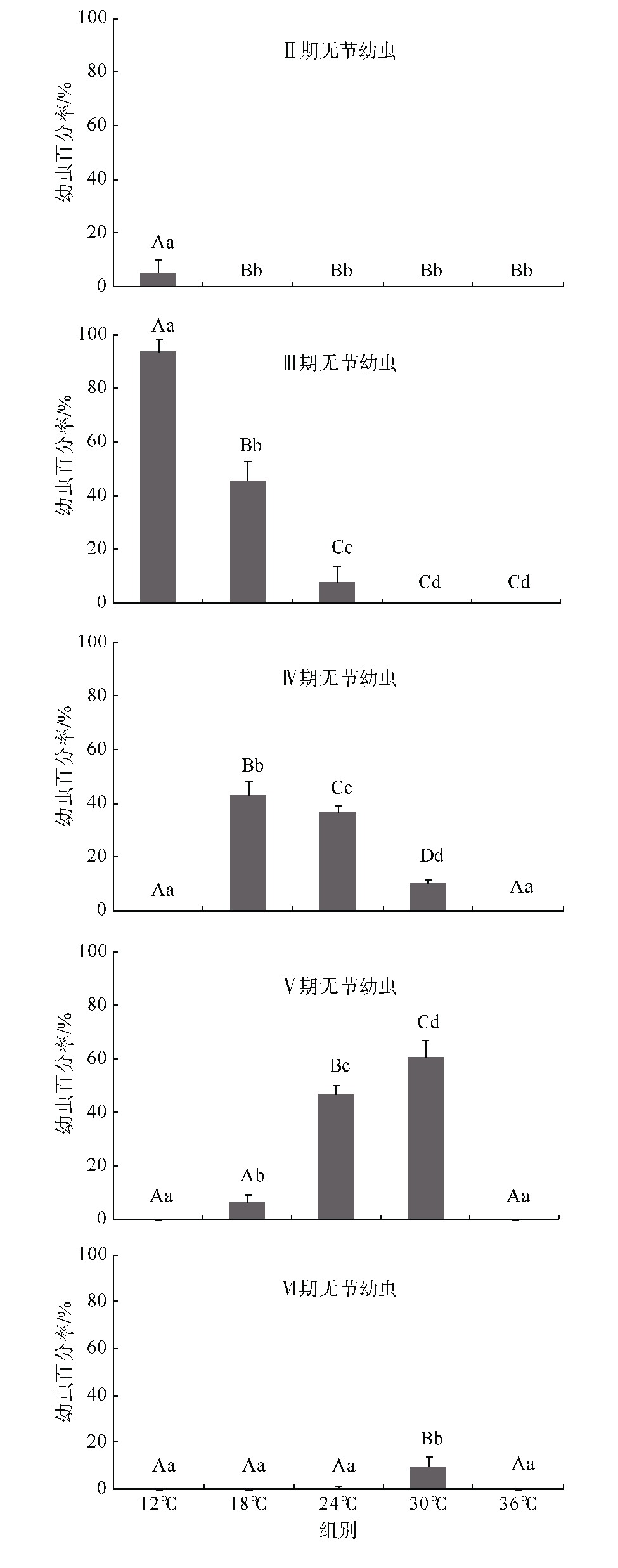
Fig.2 The percentages of larvae of Amphibalanus reticulatus at various developmental stages under different temperatures
图中标注的不同大写字母表示相关组间差异极显着(p<0.01);不同小写字母表示组间差异显着(p<0.05);相同小写字母则表示组间差异不显着(p>0.05);样品重复数n=4
2.2、 温度对幼虫附着影响
图3反映了不同温度培养条件下网纹纹藤壶金星幼虫的存活状况。可见,在96h的附着实验过程中,各温度组的金星幼虫均未出现死亡,存活率达100%。
图4则显示了不同温度培养条件下金星幼虫的附着状况。在12°C组中,始终未观察到金星幼虫附着;而18°C和24°C组,金星幼虫的附着率则始终低于30°C组;36°C组的幼虫附着率与30°C组没有显着差异(p>0.05)。96h实验结束时,各组幼虫附着率依次为0(12°C)、51.1%±16.2%(18°C)、65.9%±18.0%(24°C)、84.5%±12.1%(30°C)和76.5%±2.7%(36°C),30°C组的金星幼虫附着率为最高。
图3 在不同温度条件下网纹纹藤壶金星幼虫存活率(样品重复数n=4)
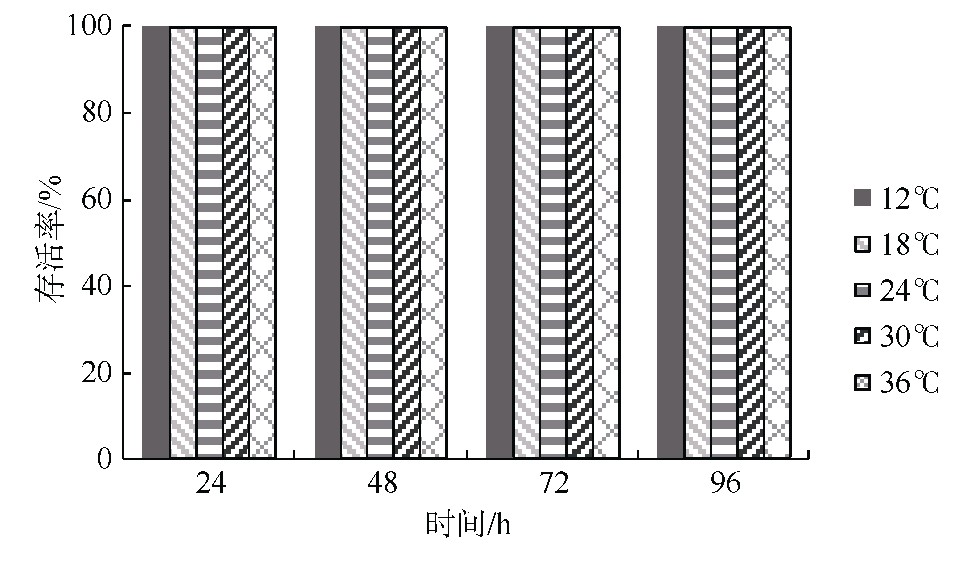
Fig.3 The cyprid survival rates of Amphibalanus reticulatus under different temperatures
图4 在不同温度条件下网纹纹藤壶金星幼虫附着率
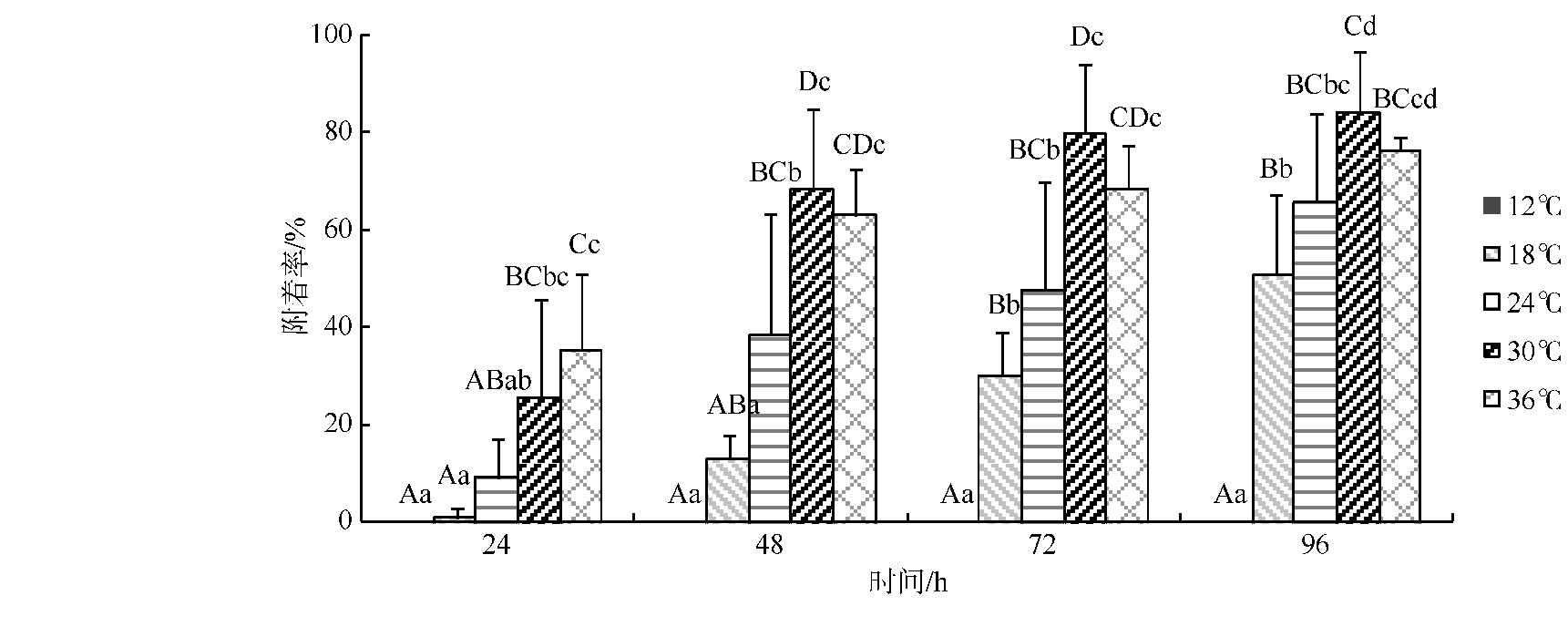
Fig.4 The larval settlement percentages of Amphibalanus reticulatus under different temperatures
图中标注的不同大写字母表示相关组间差异极显着(p<0.01);不同小写字母表示组间差异显着(p<0.05);相同小写字母则表示组间差异不显着(p>0.05);样品重复数n=4
3、 讨论
温度是影响无柄蔓足类生长(Inatsuchi et al,2010;Nishizaki et al,2015)、发育(Anil et al,1995;Inatsuchi et al,2010)、繁殖(Patel et al,1960;Chan et al,2004;Desai et al,2006)及其水平和垂直分布状况(Connell,1961;Southward,1964;Herbert et al,2007)的关键因素之一。温度降低会延缓幼虫发育,降低附着率,类似现象在藤壶(Elminius modestus)(Tighe-Ford et al,1970;Harms,1986)、纹藤壶(Amphibalanus amphitrite)(Anil et al,1995;Qiu et al,1999)、象牙纹藤壶(A.eburneus)(Scheltema et al,1982)、三角藤壶(Balanus trigonus)(Thiyagarajan et al,2003)和巨藤壶(Megabalanus coccopoma)(Crickenberger et al,2017)等多种藤壶中均有报道。
虽然温度升高有利于无柄蔓足类的生长发育,但温度上限的耐受程度取决于其保持能量平衡的能力。研究表明,贻贝的夏季死亡率与能量平衡失调有关(Tremblay et al,1998),高温妨碍其从摄入食物中获得能量(Dimitriadis et al,2012)。金星幼虫不需从外界环境摄取食物,而是凭借无节幼虫阶段积累的能量储备来满足生物体所需(严文侠等,1983;Lucas et al,1979;Harder et al,2001;Thiyagarajan et al,2005)。因此,相对于网纹纹藤壶无节幼虫而言,其金星幼虫对36°C的温度表现出更好的耐受性,实验中不仅没有出现死亡个体,而且还能观察到约76.5%的幼虫成功附着。
在幼虫附着方面,水体温度是一个极为关键的影响因素,实海挂板调查显示温带种致密纹藤壶(Amphibalanus improvisus)在平均水温为15.4°C时才可附着(黄宗国等,1980),而在我国沿岸海域广泛分布的纹藤壶,其附着的出现则需更高的温度(李传燕等,1990)。在网纹纹藤壶终年均可繁殖附着的湛江港海域,其全年水温约为17~30°C (严岩等,1995),这与本文研究结果显示的网纹纹藤壶金星幼虫附着所需的温度状况基本一致。基于水温下降会减少藤壶幼虫的附着,目前冷藏举措已成为短期储存金星幼虫的常用方法(Qian et al,1999;Miron et al,2000;严涛等,2012)。
高温处理可有效杀灭各类大型海洋污损生物(Jenner et al,1998;Rajagopal et al,2012),由于大型无脊椎动物的温度耐受上限与生物种类、个体大小、生命阶段及作用时间长短等多方面因素有关(Kennedy et al,1971;De Bravo et al,1998;Masilamoni et al,2002;Rajagopal et al,2005),再加上热处理技术的有效实施还需基于相关海域生物污损状况、优势种组成及其生物学特性等方面的数据资料(Rajagopal et al,1991),故进一步开展网纹纹藤壶热耐受性及作用机制研究具有重要的学术价值和现实意义。
4 、结论
根据网纹纹藤壶幼虫发育和附着的实验结果可以看出,在12~30°C的范围内,温度升高能显着促进其幼虫的发育和附着;12°C条件下金星幼虫无法附着;与无节幼虫相比,金星幼虫对30°C和36°C的温度环境表现出更好的耐受性。综合来看,18~30°C应为网纹纹藤壶幼虫发育及附着的适宜温度。
参考文献
[]曹文浩,王春忠,胡煜峰,等,2014.饵料对网纹藤壶幼虫发育和附着的影响[J].热带海洋学报,33(4):47-50.CAOWENHAO,WANG CHUNZHONG,HU YUFENG,et al.2014.The effect of different diet on larval growth and settlement of barnacle Balanus reticulatus[J].Journal of Tropical Oceanography,33(4):47-50 (in Chinese with English abstract).
[]曹文浩,严瑾,丰美萍,等,2018.盐度对中国东南沿海两种常见藤壶幼虫发育的影响[J].热带海洋学报,37(6):85-91.CAO WENHAO,YAN JIN,FENG MEIPING,et al.2018.Effects of salinity on larval development of two common barnacles from the southeast coast of China[J].Journal of Tropical Oceanography,37(6):85-91 (in Chinese with English abstract).
[]胡煜峰,严涛,曹文浩,等,2014.K+、Cr6+对网纹藤壶幼虫发育和存活的影响[J].生态学报,34(2):353-358.HU YUFENG,YAN TAO,CAO WENHAO,et al.2014.Effects of K+and Cr6+on larval development and survival rate of the acorn barnacle Balanus reticulatus[J].Acta Ecologica Sinica,34(2):353-358 (in Chinese with English abstract).
[]黄宗国,李传燕,张良兴,等,1980.渤海湾附着生物生态[J].海洋学报,2(3):111-122.HUANG ZONGGUO,LICHUANYAN,ZHANG LIANGXING,et al.1980.On the ecology of marine fouling organisms in the Bohai Wan (Pohai Bay),China[J].Acta Oceanologica Sinica,2(3):111-122 (in Chinese with English abstract).
[]李传燕,黄宗国,王建军,等,1990.烟台港附着生物生态研究[J].海洋学报,12(1):107-114.LI CHUANYAN,HUANGZONGGUO,WANG JIANJUN,et al.1990.An ecological study on the fouling organisms in Yantai Harbour[J].Acta Oceanologica Sinica,12(1):107-114 (in Chinese).
[]梁志,庞景梁,孙恢礼,1983.铜和pH对网纹藤壶幼虫附着的影响[J].海洋学报,5(4):526-529.LIANG ZHI,PANGJINGLIANG,SUN HUILI.1983.Effects of Copper and p Hon Larval Attachment of Barnacle Balanus reticulatus Utinomi[J].Acta Oceanologica Sinica,5(4):526-529 (in Chinese).
刘瑞玉,任先秋,2007.中国动物志,无脊椎动物,第42卷,甲壳动物亚门,蔓足下纲,围胸总目[M].北京:科学出版社:1-118,494-497.LIU RUIYU,REN XIANQIU.2007.Fauna Sinica,Invertebreata vol.42,Crustacea,Cirripedia,Thoracica[M].Beijing:Science Press:1-118,494-497 (in Chinese).
[]饶小珍,林岗,许友勤,2013.藤壶金星幼虫附着变态机制[J].生态学报,33(16):4846-4856.RAO XIAOZHEN,LINGANG,XU YOUQIN.2013.A review on the mechanism of attachment and metamorphosis in barnacle cyprids[J].Acta Ecologica Sinica,33(16):4846-4856 (in Chinese with English abstract).
[]薛俊增,堵南山,2009.甲壳动物学[M].上海:上海教育出版社:69-77.XUE JUNZENG,DU NANSHAN,2009.Crustacea[M].Shanghai:Shanghai Educational Publishing House:69-77 (in Chinese).
[]严涛,黎祖福,胡煜峰,等,2012.中国沿海无柄蔓足类研究进展[J].生态学报,32(16):5230-5241.YAN TAO,LI ZUFU,HU YUFENG,et al.2012.A review on the balanomorph barnacles in the coastal waters of China[J].Acta Ecologica Sinica,32(16):5230-5241 (in Chinese with English abstract).
严文侠,陈兴乾,1980.网纹藤壶的幼虫发育[G]//南海海洋科学集刊:第1集.北京:科学出版社:125-134.YAN WENXIA,CHEN XINGQIAN,1980.Development of the larvae of Balanus reticulatus Utinomi[G]//Nanhai Studia Marina Sinica(No.1).Beijing:Science Press:125-134 (in Chinese with English abstract).
严文侠,庞景梁,陈兴乾,1983.网纹藤壶的附着[G]//南海海洋科学集刊:第4集.北京:科学出版社:65-73.YANWENXIA,PANG JINGLIANG,CHEN XINGQIAN,1983.Settlement of Balanus reticulatus Utinomi[G]//Nanhai Studia Marine Sinica (No.4).Beijing:Science Press:65-73 (in Chinese with English abstract).
[]严岩,严文侠,董钰,1995.湛江港污损生物挂板试验[J].热带海洋,14(3):81-85.YAN YAN,YAN WENXIA,DONG YU,1995.Surveys of fouling-panels in Zhanjiang Bay[J].Tropic Oceanology,14(3):81-85 (in Chinese with English abstract).
[]张士璀,何建国,孙世春,2017.海洋生物学[M].青岛:中国海洋大学出版社:78-360.ZHANG SHICUI,HE JIANGUO,SUN SHICHUN,2017.Marine biology[M].Qingdao:China Ocean University Press:78-360 (in Chinese).
[]ANDERSON D T,1994.Barnacles:structure,function,development and evolution[M].London:Chapman&Hall:1-357.
[]ANIL A C,CHIBA K,OKAMOTO K,et al,1995.Influence of temperature and salinity on larval development of Balanus amphitrite:implications in fouling ecology[J].Marine Ecology Progress Series,118:159-166.
[]CAO WENHAO,YAN TAO,LI ZUFU,et al,2013.Fouling acorn barnacles in China-a review[J].Chinese Journal of Oceanology and Limnology,31(4):699-711.
[]CHAN B K K,WILLIAMS G A,2004.Population dynamics of the acorn barnacles,Tetraclita squamosa and Tetraclita japonica(Cirripedia:Balanomorpha),in Hong Kong[J].Marine Biology,146(1):149-160.
[]CONNELL J H,1961.The influence of interspecific competition and other factors on the distribution of the barnacle Chthamalus stellatus[J].Ecology,42(4):710-723.
[]COSSON-SARRADIN N,SIBUET M,PATERSON G L J,et al,1998.Polychaete diversity at tropical Atlantic deep-sea sites:environmental effects[J].Marine Ecology Progress Series,165:173-185.
[]CRICKENBERGER S,WALTHER K,MORAN A L,2017.Lower thermal limits to larval development do not predict poleward range limits of the introduced tropical barnacle Megabalanus coccopoma[J].Invertebrate Biology,136(1):37-49.
[]DE BRAVO M I S,CHUNG K S,P?REZ J E,1998.Salinity and temperature tolerances of the green and brown mussels,Perna viridis and Perna perna (Bivalvia:Mytilidae)[J].Revista de Biologia Tropical,46(S5):121-125.
[]DESAI D V,ANIL A C,VENKAT K,2006.Reproduction in Balanus amphitrite Darwin (Cirripedia:Thoracica):influence of temperature and food concentration[J].Marine Biology,149(6):1431-1441.
[]DIMITRIADIS V K,GOUGOULA C,ANESTIS A,et al,2012.Monitoring the biochemical and cellular responses of marine bivalves during thermal stress by using biomarkers[J].Marine Environmental Research,73:70-77.
[]HARDER T,THIYAGARAJAN V,QIAN PEIYUAN,2001.Combined effect of cyprid age and lipid content on larval attachment and metamorphosis of Balanus amphitrite Darwin[J].Biofouling,17(4):257-262.
[]HARMS J,1986.Effects of temperature and salinity on larval development of Elminius modestus (Crustacea,Cirripedia)from Helgoland (North Sea) and New Zealand[J].Helgol?nder Meeresuntersuchungen,40(4):355-376.
[]HERBERT R J H,SOUTHWARD A J,SHEADER M,et al,2007.Influence of recruitment and temperature on distribution of intertidal barnacles in the English Channel[J].Journal of the Marine Biological Association of the United Kingdom,87(2):487-499.
[]INATSUCHI A,YAMATO S,YUSA Y,2010.Effects of temperature and food availability on growth and reproduction in the neustonic pedunculate barnacle Lepas anserifera[J].Marine Biology,157(4):899-905.
[]JENNER H A,WHITEHOUSE J W,TAYLOR C J L,et al,1998.Cooling water management in European power stations:biology and control of fouling[J].Hydroécologie Appliquée,10(1-2):1-225.
[]JONES D S,2012.Australian barnacles (Cirripedia:Thoracica),distributions and biogeographical affinities[J].Integrative and Comparative Biology,52(3):366-387.
[]KENNEDY V S,MIHURSKY J A,1971.Upper temperature tolerances of some estuarine bivalves[J].Chesapeake Science,12(4):193-204.
[]KHALAMAN V V,KOMENDANTOV A Y,MALAVENDA S S,et al,2016.Algae versus animals in early fouling communities of the White Sea[J].Marine Ecology Progress Series,553:13-32.
[]LUCAS M I,WALKER G,HOLLAND D L,et al,1979.An energy budget for the free-swimming and metamorphosing larvae of Balanus balanoides (Crustacea:Cirripedia)[J].Marine Biology,55(3):221-229.
[]MASILAMONI J G,NANDAKUMAR K,JESUDOSS K S,et al,2002.Influence of temperature on the physiological responses of the bivalve Brachidontes striatulus and its significance in fouling control[J].Marine Environmental Research,53(1):51-63.
[]MIRON G,WALTERS L J,TREMBLAY R,et al,2000.Physiological condition and barnacle larval behavior:a preliminary look at the relationship between TAG/DNA ratio and larval substratum exploration in Balanus amphitrite[J].Marine Ecology Progress Series,198:303-310.
[]MUXAGATA E,WILLIAMS J A,SHEADER M,2004.Composition and temporal distribution of cirripede larvae in Southampton Water,England,with particular reference to the secondary production of Elminius modestus[J].ICES Journal of Marine Science,61(4):585-595.
[]NISHIZAKI M T,CARRINGTON E,2015.The effect of water temperature and velocity on barnacle growth:Quantifying the impact of multiple environmental stressors[J].Journal of Thermal Biology,54:37-46.
[]PATEL B,CRISP D J,1960.The influence of temperature on the breeding and the moulting activities of some warm-water species of operculate barnacles[J].Journal of the Marine Biological Association of the United Kingdom,39(3):667-680.
[]PECHENIK J A,BERARD R,KERR L,2000.Effects of reduced salinity on survival,growth,reproductive success,and energetics of the euryhaline polychaete Capitella sp.Ⅰ[J].Journal of Experimental Marine Biology and Ecology,254(1):19-35.
[]QIAN PEIYUAN,RITTSCHOF D,SREEDHAR B,et al,1999.Macrofouling in unidirectional flow:miniature pipes as experimental models for studying the effects of hydrodynamics on invertebrate larval settlement[J].Marine Ecology Progress Series,191:141-151.
[]QIU JIANWEN,QIAN PEIYUAN,1999.Tolerance of the barnacle Balanus amphitrite amphitrite to salinity and temperature stress:effects of previous experience[J].Marine Ecology Progress Series,188:123-132.
[]RAJAGOPAL S,JENNER H A,VENUGOPALAN V P,2012.Operational and environmental consequences of large industrial cooling water systems[M].New York:Springer:227-272.
[]RAJAGOPAL S,SASIKUMAR N,AZARIAH J,et al,1991.Some observations on biofouling in the cooling water conduits of a coastal power plant[J].Biofouling,3(4):311-324.
[]RAJAGOPAL S,VAN DER VELDE G,VAN DER GAAG M,et al,2005.Factors influencing the upper temperature tolerances of three mussel species in a brackish water canal:Size,season and laboratory protocols[J].Biofouling,21(2):87-97.
[]SCHELTEMA R S,WILLIAMS I P,1982.Significance of temperature to larval survival and length of development in Balanus eburneus (Crustacea:Cirripedia)[J].Marine Ecology Progress Series,9:43-49.
[]SOUTHWARD A J,1964.The relationship between temperature and rhythmic cirral activity in some Cirripedia considered in connection with their geographical distribution[J].Helgol?nder Wissenschaftliche Meeresuntersuchungen,10(1-4):391-403.
[]SUKPARANGSI W,POCHAI A,WONGKUNANUSORN C,et al,2019.Discovery of Neonrosella vitiata (Darwin) and Newmanella spinosus Chan&Cheang (Balanomorpha,Tetraclitidae) from the Andaman Sea,eastern Indian Ocean[J].ZooKeys,833:1-20.
[]TAN S H,WONG T M,1996.Effect of salinity on hatching,larval growth,survival and settling in the tropical oyster Crassostrea belcheri (Sowerby)[J].Aquaculture,145(1-4):129-139.
[]THIYAGARAJAN V,HARDER T,QIAN PEIYUAN,2003.Combined effects of temperature and salinity on larval development and attachment of the subtidal barnacle Balanus trigonus Darwin[J].Journal of Experimental Marine Biology and Ecology,287(2):223-236.
[]THIYAGARAJAN V,HUNG O S,CHIU J M Y,et al,2005.Growth and survival of juvenile barnacle Balanus amphitrite:interactive effects of cyprid energy reserve and habitat[J].Marine Ecology Progress Series,299:229-237.
[]THIYAGARAJAN V,NAIR K V K,SUBRAMONIAM T,et al,2002.Larval settlement behaviour of the barnacle Balanus reticulatus in the laboratory[J].Journal of the Marine Biological Association of the United Kingdom,82(4):579-582.
[]THIYAGARAJAN V,VENUGOPALAN V P,SUBRAMONIAM T,et al,1996.Rearing of barnacle Balanus reticulatus Utinomi larvae using the diatom Chaetoceros wighami as food[J].Indian Journal of Marine Sciences,25(4):365-367.
[]TIGHE-FORD D J,POWER M J D,VAILE D C,1970.Laboratory rearing of barnacle larvae for antifouling research[J].Helgol?nder Wissenschaftliche Meeresuntersuchungen,20(1-4):393-405.
[]TREMBLAY R,MYRAND B,SEVIGNY J M,et al,1998.Bioenergetic and genetic parameters in relation to susceptibility of blue mussels,Mytilus edulis (L.) to summer mortality[J].Journal of Experimental Marine Biology and Ecology,221(1):27-58.
[]ZHANG HUI,CAO WENHAO,WU ZEWEM,et al,2015.Biofouling on deep-sea submersible buoy systems off Xisha and Dongsha Islands in the northern South China Sea[J].International Biodeterioration&Biodegradation,104:92-96.
[]ZIADI B,DHIB A,TURKI S,et al,2015.Factors driving the seasonal distribution of zooplankton in a eutrophicated Mediterranean Lagoon[J].Marine Pollution Bulletin,97(1-2):224-233.





